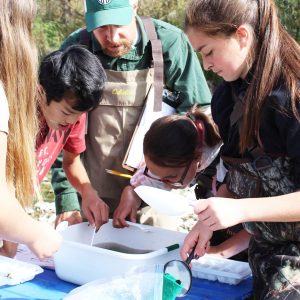
Seventh grade students in Jacki Riffey’s science class at Florence-Carlton School got a chance to go down to the Bitterroot River near the Florence bridge last week and do some real research by participating in a stream monitoring field trip sponsored by the Watershed Education Network (WEN). The field trips are a great way for students to get out of the classroom, get field science experience, and learn about their watershed from a scientific inquiry perspective.
“The kids love the river and the outdoors,” said Riffey. “It’s good for them to learn about it and how to keep it healthy so their children will be able to enjoy it as well.”
In the big picture, according to WEN executive director Deb Fassnacht, stream monitoring helps students become more familiar with their local waterways. And once acquainted with local streams, they are more apt to notice changes in watershed health. In this process, students begin to understand how local waterways fit into the larger picture of the watershed. Additionally, increasing awareness and sense-of-place relationships naturally encourages watershed stewardship.
On the field trip the students measure chemical, physical and biological parameters. They use advanced Surface Water Testing kits to measure nutrients, turbidity, minerals and electro-conductivity.
At the chemical station, students measure pH, Dissolved Oxygen (DO), water temperature, and air temperature. Three readings are taken with a field pH meter. Dissolved Oxygen is measured using Hach Kits, in which there are a series of chemicals to add to a water sample that indicate the parts per million of dissolved oxygen. The results reveal whether or not oxygen levels are sufficient for the needs of the aquatic life present.
Temperature directly affects the DO, and as such, helps samplers determine causes for increased oxygen depletion or absorption. The correlation between oxygen and temperature is an inverse relationship: as temperature rises, the amount of dissolved oxygen decreases; as the water temperature decreases, the water contains more oxygen (except in deep water lakes).
Physical station parameters record stream cross-section, velocity, substrate, bank condition, and channel shape. Visual observations include adjacent land-use, plants, wildlife, and human activity (human presence, footpaths, trash, impacts on plants) soil type, and any restoration efforts. Missoula County Weed District coordinator ???? was on hand to help the students distinguish between native vegetation and invasive species.
At the biological station, students sampled aquatic macro- invertebrates (small, water-living insects without a backbone or with an exoskeleton). Certain insects, such as mayflies, stoneflies and caddisflies, require cold, clean and clear water for survival. As such, these bugs are indicators of healthy streams.
WEN volunteer Chris Prange showed the students how to collect the macroinvertebrates with a skimming net and then sort them out.
Although the field trips are a fun learning experience for the students, the work they do in the field is for real.
“This data will be looked at by experts,” said Prange. He said it will be examined to determine the relative health of the river.